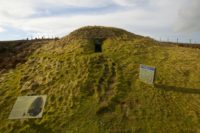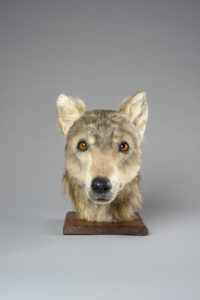Using facial reconstruction technology to recreate the visages of long-ago people is a fashionable trend in archaeology. Now for the first time that technology has been applied to man’s best friend: a Neolithic dog whose skeletal remains were found in a tomb on Orkney.
 Built between 3000 and 2400 B.C., the Cuween Hill chamber tomb on Orkney was first excavated in 1901. The cairn features a passageway leading to a central chamber with four small cells opening off it. The remains of at least eight people were found inside — five skulls in the central chamber, two in two of the side cells, one at the entrance — and the remains of numerous dogs. Skulls and bones from 24 dogs were discovered on the floor of the central chamber. Radiocarbon testing dated them to 500 years after the tomb was built, which means they were added to the cairn by residents, likely for symbolic or ritual purposes.
Built between 3000 and 2400 B.C., the Cuween Hill chamber tomb on Orkney was first excavated in 1901. The cairn features a passageway leading to a central chamber with four small cells opening off it. The remains of at least eight people were found inside — five skulls in the central chamber, two in two of the side cells, one at the entrance — and the remains of numerous dogs. Skulls and bones from 24 dogs were discovered on the floor of the central chamber. Radiocarbon testing dated them to 500 years after the tomb was built, which means they were added to the cairn by residents, likely for symbolic or ritual purposes.
 Historic Environment Scotland (HES) commissioned the Diagnostic Imaging Service at Edinburgh University’s Royal (Dick) School of Veterinary Studies to CT-scan one of the Cuween dog skulls in the collection of the National Museums Scotland. Armed with the detailed scan, HES’s Digital Documentation team produced a 3D print of the skull. Forensic artist Amy Thornton used the printed skull as the base for a realistic reconstruction of the dog’s head. It was not an easy task.
Historic Environment Scotland (HES) commissioned the Diagnostic Imaging Service at Edinburgh University’s Royal (Dick) School of Veterinary Studies to CT-scan one of the Cuween dog skulls in the collection of the National Museums Scotland. Armed with the detailed scan, HES’s Digital Documentation team produced a 3D print of the skull. Forensic artist Amy Thornton used the printed skull as the base for a realistic reconstruction of the dog’s head. It was not an easy task.
Amy Thornton, who trained in facial reconstruction methods while undertaking an MSc in Forensic Art at the University of Dundee, said: “This reconstruction has been a particularly interesting project to be involved in, as it marks the first time I’ve employed forensic methods that would usually be used for a human facial reconstruction and applied these to an animal skull.
“This brought its own set of challenges, as there is much less existing data relating to average tissue depths in canine skulls compared to humans.
“The reconstruction was originally created in clay using traditional methods, with a 3D print of the Cuween Hill skull as the base to build the anatomy on to. The completed sculpture was then cast in silicone and finished with the fur coat resembling a European grey wolf, as advised by experts. The resulting model gives us a fascinating glimpse at this ancient animal.”
Osteological analysis of the bones found in the cairn indicate he was a big boy, the size of a large collie. Archaeologists think the dog were active members of the farming and herding communities of Late Neolithic Orkney.
Steve Farrar, Interpretation Manager at HES, said: “Just as they’re treasured pets today, dogs clearly had an important place in Neolithic Orkney, as they were kept and trained as pets and guards and perhaps used by farmers to help tend sheep.
“But the remains discovered at Cuween Hill suggest that dogs had a particularly special significance for the farmers who lived around and used the tomb about 4,500 years ago. Maybe dogs were their symbol or totem, perhaps they thought of themselves as the ‘dog people’.
Or maybe they interred their most beloved dogs in the symbolically important cairn for their own sake, as the most of elite pet cemeteries.
That dog is from a time abound 5k years after the ice age ended and from a place pretty far up the globe.
https://goo.gl/maps/wV6PpyTtMy9ifbQC9
5 thousand years is a long time…. Neat story!
Ritual/totemic interral is more likely, as iirc, other tombs on Orkney have other animal and bird remains. Otters and eagles are the two that spring to mind.
And did the “dog people” have periodic tribal councils with the more introverted neighboring cat people clan?
If it was Scottish Wild Cats it’s more likely the dog people would have been in hiding! 😁
Facial reconstruction has confirmed that he was a good dog.
If that is, where the dogs where found, we clearly have identified the ‘delivery entry’. –Although it may be more straightforward just to eat the sheep.
Combined, it could give “Canivorous Mutton”, …(OK, I reckon that’s another dish for yet another time.)
——–
PS: Cats, by the way, were believed to have been domesticated in ancient Egypt, …until a group of archaeologists found remains of an 8-month-old cat -dated 7500 BC- buried with a human (the owner? food reserve?) at a Neolithic site in Cyprus. >° °<
It is a pretty good result for the method that was used.
That said, I am a bit puzzled as to why they did not use an expert in the field. I believe that the result would be more lifelike.
Taxidermists no longer “stuff” animals, they sculpt, and many are true experts on animal musculature.
When I was 14 or 15, we visited a museum. I sarted talking to a guy who I assumed was a fellow tourist. The museum had animal mounts, and I expressed an interest in them.
It so happened that I was visiting with a department head who asked my parents if he could take me back for a behind the scenes look at the end process where they sculpted the forms and musculature on the skulls prior to mounting the hides.
They had a desire to do their best by the animals, and display them at their finest. They were artists. For me was a highlight of that trip.